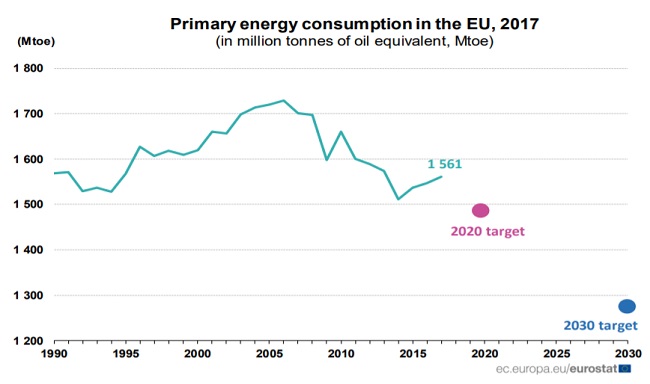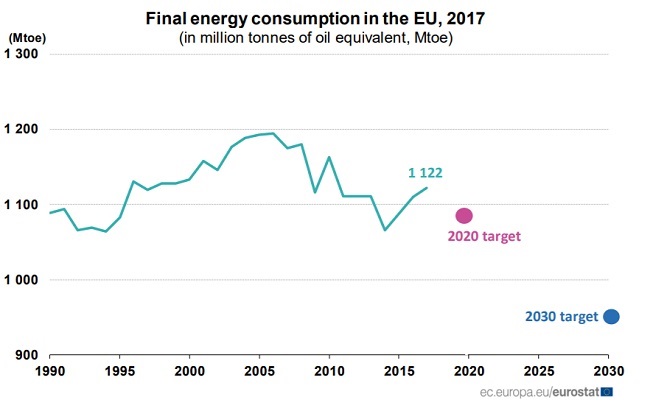In 2017, energy consumption in the European Union (EU) continued to increase for the third consecutive year, thus
moving away from the energy efficiency targets. Primary energy consumption amounted to 1 561 million tonnes of
oil equivalent (Mtoe), while final energy consumption reached 1 222 Mtoe. Compared with last year, both levels
increased by around 1%, informed Eurostat.
The EU has committed itself to binding energy efficiency target of reducing energy consumption by 20% by 2020.
The primary energy consumption should amount to no more than 1 483 Mtoe and final energy consumption to no
more than 1 086 Mtoe in 2020. The revised Energy Efficiency Directive provides for a new energy efficiency target
for 2030: a primary energy consumption of no more than 1 273 Mtoe and a final energy consumption of no more
than 956 Mtoe (equivalent to a reduction of 32.5%).
In 2017, primary energy consumption in the EU was 5.3% above the efficiency target for 2020. Since 1990, the first
year for which data are available, consumption has fallen by 0.4%. However, over the years, the primary energy
consumption has fluctuated greatly. It peaked in 2006 (1 729 Mtoe representing a 16.6% gap from the 2020 target),
while a record low was reached in 2014 (1 511 Mtoe representing a 1.9% gap from the 2020 target). Over the last
three years the consumption rose again, to 1 537 Mtoe in 2015, 1 547 Mtoe in 2016 and 1 561 Mtoe in 2017.

These figures are issued by Eurostat, the statistical office of the European Union, and are complemented by an
article on energy saving in the EU.
In 2017, final energy consumption in the EU was 3.3% above the efficiency target for 2020. Final energy
consumption in the EU peaked in 2006 (1 195 Mtoe) and decreased by 0.6% p.a. between 2006 and 2017 (1 122
Mtoe). Since the beginning of the new millennium, the lowest level of final energy consumption was recorded in
2014
(1 065 Mtoe, 1.9% below the 2020 target). In the last three years, it has increased again to 1 088 Mtoe in 2015,
1 110 Mtoe in 2016, and 1 122 Mtoe in 2017.
Primary energy consumption fell most in Estonia, rose most in Malta over last year
In 2017, primary energy consumption fell compared to the previous year in eight Member States: Estonia (-4.2%,
5.6 Mtoe in 2017), the United Kingdom (-1.6%, 177.0 Mtoe), Ireland (-1.4%, 14.4 Mtoe), Sweden (-1.6%, 46.1
Mtoe), Finland(-1.2%, 31.7 Mtoe), the Netherlands (-0.5%, 64.5 Mtoe), France (-0.3%, 239.5 Mtoe) and Belgium
(-0.3%, 49.1 Mtoe). The highest increase was recorded in Malta (+12.9%, 0.8 Mtoe in 2017), followed by Romania
(+5.8%, 32.4 Mtoe), Spain (+5.4%, 125.6 Mtoe) and Slovakia (+5.1%, 16.1 Mtoe).
Among the 25 Member States where primary energy consumption decreased between 2006 and 2017, Greece
(-2.4% p.a.) and Lithuania (-2.2% p.a.) recorded average annual decreases during the period of more than 2%.
Consumption increased in Estonia (+1.2% p.a.), Poland (+0.7% p.a.) and Austria (+0.1% p.a.).
Final energy consumption decreased most in Belgium, increased most in Slovakia in 2017
In 2017, final energy consumption fell compared to 2016 in only four Member States: Belgium (-1.2%, 36.0 Mtoe in
2017), the United Kingdom (-0.8%, 133.3 Mtoe), Italy (-0.6%, 115.2 Mtoe) and Slovenia (-0.3%, 4.9 Mtoe). The
highest increases were recorded in Slovakia (+7.0%, 11.1 Mtoe in 2017), Malta (+6.7%, 0.6 Mtoe) and Poland
(+6.5%, 71.0 Mtoe).
Among the 23 Member States where final energy consumption decreased between 2006 and 2017, only Greece
(-2.3% p.a.) recorded an average annual decrease of more than 2%. Consumption grew in Malta (+2.7% p.a.),
Poland (+1.4% p.a.), Lithuania (+0.7% p.a.), Austria (+0.3% p.a.), and Hungary (+0.1% p.a.).
 Print version
Print version









 «The Baltic Course» Is Sold and Stays in Business!
«The Baltic Course» Is Sold and Stays in Business!

